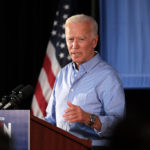
Wikimedia Commons
As calls for filibuster reform gain momentum on the national stage, Yale Law School professors shared their opinions on the long-standing Senate procedure.
The filibuster, a practice commonly used by the Senate minority party to delay and block legislation, hinges on the requirement that a supermajority of 60 senators is needed to invoke cloture — the process of ending debate and proceeding to a vote. In practice, this procedure effectively necessitates 60 votes to secure the passage of any bill. As Democrats struggle to advance their agenda in the evenly split Senate — including an ongoing battle over a prominent voting rights bill — President Joe Biden has indicated his support for a return to the so-called talking filibuster, which would require senators to hold the floor while objecting to legislation.
Currently, senators need only raise an objection to a bill to induce the 60 vote requirement — a burden that would increase by requiring objecting legislators to speak overtly and continuously on the Senate floor. Although he did not offer specifics, Biden also suggested the possibility of taking further steps to reform the filibuster — a custom he agrees with former President Barack Obama to be a “relic of the Jim Crow era.” Three YLS professors expressed their support for ending the filibuster in its entirety.
Law and history professor John Fabian Witt and Stanford JD and Ph.D. student Magdalene Zier co-authored a March 18 Washington Post piece in which the pair discussed the history of the filibuster as a tool for denying civil rights legislation. Specifically, Witt and Zier outlined the role of the filibuster in defeating the Dyer Anti-Lynching Bill — a measure introduced by former Rep. Leonidas Dyer (R-Mo.) seeking to establish lynching as a federal crime — in 1922.
“The first modern filibusterers transformed a procedural tactic into a powerful tool for entrenching white supremacy and thwarting progress,” the pair wrote. “Critics at the time angrily and correctly labeled the stagnant 1922 legislature the ‘Do-Nothing Congress.’ When assessing their fealty to the filibuster today, senators from both parties should be wary of earning the same epithet.”
In an email to the News, YLS professor of jurisprudence and professor of history Samuel Moyn wrote that the filibuster is merely one of many mechanisms that block majority rule.
He added that since the procedure has no origin in the Constitution, it “ought to be the first one to go.”
“I would prefer to see the filibuster removed entirely,” Moyn wrote to the News. “Not only has it played a noxious role in our history, but its virtues are more apparent than real, and far outweighed by its vices — especially in a country that needs to save itself from a syndrome of minority rule.”
For over a decade, Sterling Professor of law and political science Akhil Amar has been at the intellectual forefront of filibuster reform. In 2011, Amar co-authored a Slate piece with former Sen. Gary Hart DIV ’61 LAW ’64 (D-Colo.) entitled “How To End the Filibuster Forever,” which supported the use of the so-called nuclear option to eliminate the filibuster, arguing that the framers of the Constitution believed in Senate majority rule. Further, the piece sought to demonstrate that the nuclear option could be invoked on any day, not just on the Senate’s opening day, as was widely believed at the time.
The nuclear option is a procedure that allows the Senate to override a standing rule of the chamber — such as the filibuster — by a simple majority vote. After Amar and Hart’s piece circulated among senators and staffers, the nuclear option was used by Senate Democrats in 2013 — led by former Senate Majority Leader Harry Reid (D-Nev.) — to remove the filibuster for executive branch nominations and federal judicial appointments. In 2017, Senate Republicans — led by former Senate Majority Leader Mitch McConnell (R-Ky.) — extended the elimination of the filibuster to include Supreme Court nominations, thus confirming the appointment of now Supreme Court Justice Neil Gorsuch. In his 2016 book “The Constitution Today: Timeless Lessons for the Issues of Our Era,” Amar applauded both moves and suggested further use of the nuclear option to eliminate the filibuster completely.
“On any future day, the Senate can extend Reid’s reform to any other aspect of Senate business, including ordinary legislation,” Amar wrote in his book. “We now live in a nuclear world, and there is no going back.”
Still, Republican legislators and some Democrats have continued to defend the filibuster.
In a speech given on the floor of the Senate last week, Sen. Ben Sasse GRD ’04 (R-Neb.) said the filibuster promotes bipartisanship and compromise, suggesting that his Democratic colleagues have changed their opinions on the practice only because they are now in power.
“We know what it looks like to have a simple majoritarian body,” Sasse said on the Senate floor, referring to the House of Representatives. “But the Senate’s job, the Senate’s purpose, is different. … The Senate exists to act with a cool head. Our job is not to cater to sudden and instant majorities, and to changes in the wind. The Senate’s job is to enlarge and refine the House’s judgements, and to try to build consensus that can last, so that the majority’s will can be advanced, while the minority’s rights are also protected.”
Sasse added that the elimination of the filibuster will “come at a long-term cost of the entire structure of the rights and interests of our constitutional balance.”
However, Amar denies that the Senate is fundamentally different from the House with regard to majority rule.
“There is nothing in the Constitution that suggests the Senate is any different,” Amar and Hart wrote in their Slate piece. “And throughout the Founding era, the Senate practiced and preached majority rule.”
The first Senate filibuster was exercised in 1837 by a group of Whig senators seeking to prevent the removal of a censure resolution against then-President Andrew Jackson.
Zhemin Shao | zhemin.shao@yale.edu









